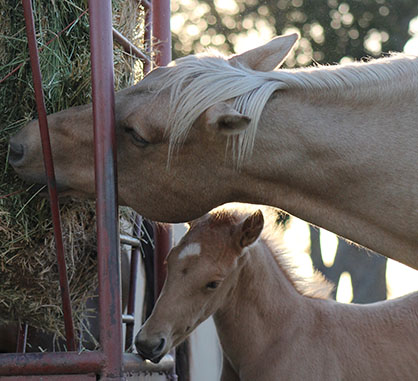Introducing a New Horse to the Barn
Horizon Structures Presents Series….New Horse New Barn ~ Recipe for Successful Introduction
by: Horizon Structures, LLC/Nikki Alvin-Smith
Your dream has been realized and your new barn purchase has gone smoothly. The crew just left after promptly assembling your splendid modular barn and setting everything fair, in readiness for your new horse to arrive. It is an exciting time!
Here is a recipe for a successful introduction for your new horse to his new environment. You want everything to go as smoothly as possible and the early days of your relationship with your new horse is the perfect time to build a solid foundation of trust.
Set The Stall Up For Success
Your plush new stall, with kick boards set to a minimum of 4 feet high and rubber mats laid over the compacted stonedust, provides a safe environment for your horse. You’ll need to add bedding before he arrives, and it is prudent to bank the bedding around the stall just in case he gets down to roll after his trailer journey. You don’t want to start off your relationship wrestling with a ‘cast’ horse.
Water buckets and mangers should be hung a minimum of four feet from the ground to help prevent a horse from kicking them or hanging his hoof up in a bucket handle. Personally, I always feed my horses from mangers on the ground as I consider this a more natural position for them to eat. If the manger is removable (which it should be for regular cleaning), then I’d remove it until the horse has settled in for a few hours.
Hay should be provided either on the ground, or in a haybag, haynet or hay manger. Be certain not to place hay providers too high above the horse’s head, as hayseed will bother his eyes when he pulls down hay to eat. I recommend placing hay in two piles, one each side of the stall once the horse has settled down, as it encourages him to walk from one side of the stall to the other to eat and helps defray a hungry horse from eating quite as quickly. With two available hay piles the horse doesn’t worry that the hay stash will disappear. If at all possible, blend your hay with hay that the horse has already been used to at his previous abode. I always ask for a few bales of hay to be shipped with the horse if possible, so we can blend the old with the new for a few days.
Keep an additional water bucket handy with electrolytes available. If your horse arrives off the trailer and shows any sign of stress or tension, and certainly if he has been sweating during transport, you may want to add a second bucket of water that has been infused with electrolytes. Always offer both plain and infused water so he has the option to choose what he needs.
Ensure that the aisleway and/or area immediately around the barn is kept clear of any obstacles that may cause injury to an excited horse or cause a horse to spook. Put pets and any other animals such as alpacas/goats etc. away, before your new horse arrives, and try to minimize noise and distractions until he has had a chance to settle in.
Woohoo! Your New Horse is Here!
Ideally, any horse coming off a trailer should be hand grazed. Not only will this settle the horse mentally but it also offers a valuable digestive aid for their systems after a long trailer ride. However, in the excitement of coming off the trailer your new equine partner may not be able to settle or focus on grazing. In this case take him straight into his new stall. After he has settled down you can always try again.
Horses settle much more quickly if there is another horse in proximity on their arrival. As you may want to quarantine your new horse for a while before introducing him to any other horses on the property, you may not want to stall a compatriot close by. As long as the new arrival can see another horse in a paddock or field on the property, it will be a beneficial calming influence. Don’t fret if whinnying erupts when the horses see each other. Just ignore it. It will soon stop.
Try to minimize interaction between the new horse and different people during the first 24 hours. It is kindest to limit access to those that will be his regular caregivers such as yourself and immediate family. Save the ‘showing off’ the new horse to friends, until he has had a chance to come to know you and trust has been established.
It is prudent not to overwhelm your new horse with noise, too much fuss or continual chatter. Make a cursory inspection of your horse to ascertain he has not sustained any injury from the transport. Once he starts to munch on his hay and looks reasonably settled, leave him in peace for a few hours. You can check in on him but try to avoid the need to encroach in his stall space or play with him. There will be plenty of time for that later.
The First 24 Hours
Personally, I like to stall my new equine arrivals for 24 hours before turn out. This gives them time to settle in and rest. The barn is a safe haven from heat and cold, a box stall is a safe space and I can readily observe the horse’s health. Check his vital signs such as temperature and pulse, and ensure he is drinking adequate amounts of water and producing manure. I personally avoid any graining for the first 24 hours to reduce the chance of colic, though I do confess to providing liberal quantities of carrots. If you have any concerns regarding the horse’s health don’t hesitate to call your vet for advice.











